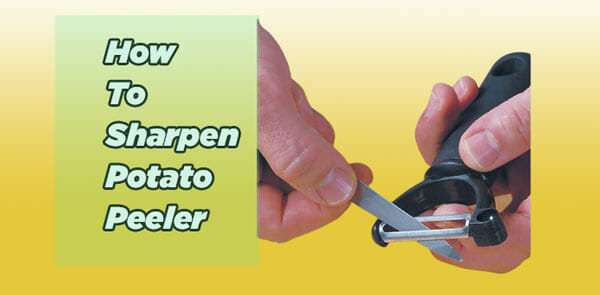Peeling potatoes isn’t the easiest task on the planet. It can be quite tedious. Especially when you have to peel a lot of them to make French fries for that party you decided to host, or maybe to make the potato salad that you so graciously volunteered to bring to the next potluck. Just thinking about it bores us.
This tiresome activity can become even more of a chore if you have a peeler that isn’t in tiptop shape. A blunt potato peeler is one of the most inefficient tools you can have in your kitchen.
Don’t worry though, we’ve got your backs with 4 different methods to make sure your peeler never disappoints you again. But first, why do you even need a sharp potato peeler? What makes a blunt one so inefficient?
So, if you don’t know how to sharpen potato peeler, check this write-up.
Why Is It Important To Keep Your Potato Peeler Sharp?
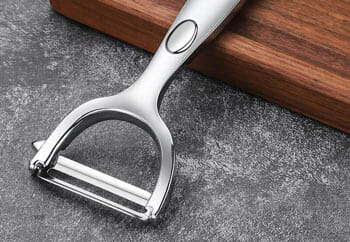
A potato peeler can either be your best friend or your worst enemy, depending on how sharp you keep it. What makes us say that? Here are 4 reasons why you will be let down by a dull peeler.
1. You’re Going To Have To Put In A Lot More Effort
First and foremost, a blunt peeler is not going to glide right past your potato like the sharp one would. These peelers tend to take a lot more force to do the job. It’s basic physics, dull objects are more affected by friction.
In other words, you are going to have to push down with all you might for each peel. We don’t need to tell you how fast that is going to get old.
In contrast, a sharp peeler is going to be super easy to use. You can save your energy for the rest of the cooking process.
2. Time Management Will Be Tough
So, putting in a bit of elbow grease doesn’t bother you all that much? You’ll be disappointed to know that energy isn’t the only thing you’ll be losing. An important cost to consider is the time it is going to take.
Dishes that would take only 10 minutes to make may take twice or even thrice the time because you couldn’t peel your potatoes or carrots in time. Other than losing valuable time, it also means that you may fluff up recipes.
Say you planned to make some mashed potatoes to accompany your roast beef and you expected to be done with your side dish by the time your meat left the oven. Can you guess what is going to happen with a dull peeler?
Your potatoes may take so much time to peel that the beef overcooks in case you have left it in the oven, or it gets cold if you have taken it out. Either way, your meal has downgraded big time.
This is just a hypothetical scenario of course, but you will need to prepare for a potential disaster like this for every meal plan. That isn’t a fun time as a chef.
3. Risk Of Injury
The problem with a blunt peeler is very similar to that of a blunt knife. We are sure you’ve heard of plenty of incidents where a dull knife caused someone to get a cut. The same thing may happen with a blunt peeler.
You aren’t going to be able to get the job done in one motion and that is going to prompt you to peel multiple times in one area.
On top of that, you are using maximum force and working hurriedly due to the last two issues we spoke of.
This is very dangerous. One missed stroke might lead you to take a swing at your hand or other parts of your body.
4. Your Blade May Become Ineffective
Lastly, if you neglect your potato peeler for too long, you may find that it has lost a lot of its sharpness and has become nothing but a scrap metal. We’re all for utilizing something to its fullest, but this situation can easily be avoided with a few good sharpening sessions.
Factors To Consider Before Picking A Method To Sharpen Your Peeler
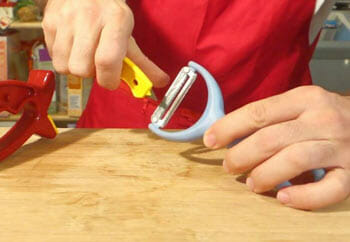
You’re convinced to sharpen your peeler? That’s great news! There is one tiny bit of trivia before we finally get to the methods of sharpening your peeler. You need to analyze three things about your peeler before picking a method.
1. Quality Of Your Peeler
Here is the thing- a cheap peeler is never going to get good, Like most kitchen tools, we think a small investment goes a long way here. If you have a peeler made of low-quality steel, we suggest chucking it in the bin and buying a good one. Trust us, the money will be well-spent.
2. Type Of Potato Peeler
You may have the best peeler in the world, but all methods of sharpening may not work on it. That is because all peelers are not of the same type. The three most popular forms of peelers: are the swivel, Lancashire, and Y peeler.
Each type looks and functions differently, and so must be sharpened differently. You need to try each method to see which one works best on your peeler.
3. Type Of Blade
Along with the type of peeler, you also need to keep an eye out for the type of blade. You may have a smooth or serrated blade. You may even have a julienne peeler which has a blade that allows you to peel potato skins in neat strips so you can use them for future applications. Each blade works best with a different type of sharpening method.
How to Sharpen Potato Peeler? 4 Different Methods Explained
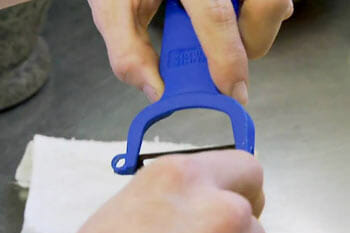
At last, you have all the precursory knowledge you need to understand these methods. So, without further ado, here are the 4 best methods to sharpen your peeler.
A. Turn Things Around
The first method is by far the easiest and least time-consuming. There is a catch, unfortunately. It doesn’t work on all peelers. It only works on those with a detachable blade. So, if you don’t have that, move on to the next method. Here are the steps-
Step 1: Pry Open The Blade
Start by gently tugging at the blade to remove it from the handle. You need to be very careful here as the blade may still be capable of cutting you.
Step 2: Check The Sharpness Of The Other Side
Most probably, the other side of your blade is going to be sharp as if you never used it. But in some cases, the other side may also have dulled out.
In that case, we suggest sharpening the blade while it is off the handle with any of the following methods. Because it is going to be infinitely harder if the blade is attached to the handle.
Step 3: Put It In Place
Once you’ve found (or created) a sharp side, just snap the blade back in place with that side facing up. This method is done, you can now peel potatoes at lightning speed again.
B. Use A Knife Sharpener
If you don’t have a detachable blade, there is no need to worry. This step and the next two don’t need you to remove the blade from the peeler, and they are not challenging either. Here are the steps-
Step 1: Find The Right Knife Sharpener
This is going to be the hardest part of this process which goes to show just how simple this method is. You need to find a thin sharpener that can easily fit in between your blades.
Step 2: Insert The Sharpener In Between Your Blades
Now that you’ve found the sharpener you need, it’s time to put it to use. First, though, you need to see if the sharpener is touching both sides of the blade. If not, you are going to have to push both ends closer with pliers. This is going to take a bit of effort. So be prepared for that.
Step 3: Use Strong And Steady Strokes
All that is left to do is to move the sharpener along the blade with force, pressure, and intent. If you have a serrated blade, make sure you follow the jagged edges so you don’t flatten them. With that, you should be able to rifle through potatoes with ease.
C. Using A Nail Filer Or Kitchen Knife
The second and third steps are quite similar but the third step is a lot easier. It won’t bring you equally good results but it will be effective nonetheless. Here are the steps-
Step 1: Put The Knife Or Filer In Between The Blades
Take the smallest knife or nail filer you can find. Place it into the gap of your peeler. This won’t be too tough to find as nail filers tend to be small and most knives aren’t that big- unless you grab a chef’s knife. It is important to note that you need a sharp knife or a high-quality filer for this purpose.
Step 2: Move It Back And Forth
Take the knife or file and gently slide it across each blade using a saw motion. In case you have a serrated blade, do not use a filer. If you use a knife, remember to only sharpen the crevices of knife. That’s all there is to it. You should have a much sharper potato peeler on your hands now.
D. Using Stones
You are going to need two special types of stones for this. Here are the steps-
Step 1: Find A Small Slip Stone And Flat Stone
The stones we were talking about are slip stones and flat stones. These stones are used for knife sharpening but they are good to use here as well. You just need to find ones that are small enough. Don’t even consider this method if you have a serrated blade as it will flatten out your specialized peeler.
Step 2: Use The Flat Stone
Take the flat stone and put it in the opening of your peeler. Rub the stone against the blade so that the blunt edges are sharpened with the magic of friction.
Step 3: Use The Slip Stone
You just need to add a few finishing touches now. Place the slip stone in between your blades and repeat step 3 to remove any uneven edges. This is why this method is an absolute no-no for serrated peelers. Voila! You have a sharp peeler.
Tips And Cautions For When Sharpening Potato Peeler
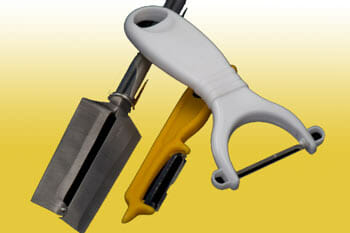
You now know four different ways to sharpen your peeler. Before we wrap things up though, there are a few warnings and suggestions we’d like to give you.
1. The Blade Is Sharper Than You Think
When working with any blunt blades, we tend to underestimate how dangerous they are. Remember that the blade is not sharp enough to serve its purpose, but it still may be sharp enough to injure you.
2. Try Every Method
If you try just one method, there is a good chance that it won’t work. That is because each peeler is different and needs to be treated differently. We advise you to try all methods before calling it a day.
3. Know When To Give Up
Speaking of calling it a day, you need to know the difference between persistence and foolishness. If a method seems to be failing, do not waste too much time on it, move on to the next one.
If none of the methods work, rather than trying them all again, just buy a new
peeler. Your time has an economic value as well so you aren’t saving any money by wasting your precious hours behind 1 peeler.
Frequently Asked Questions
1. What Causes A Peeler To Dull?
A peeler dulls due to constant usage. Because the blades work on so many potatoes, they eventually wear out. It is natural and is bound to happen sooner or later. So be ready to sharpen it.
2. Is There A Special Tool To Sharpen Peelers?
Unfortunately, there is no sharpening tool specifically built with peelers in mind. That is because- this is too much of a niche and the methods we mentioned are usually enough to get results.
3. How Often Should I Sharpen My Peeler?
The answer is- If you are lucky enough, very rarely. As we said, the dulling out is going to happen to any blade after a certain amount of time or usage no matter how high quality it is. However, better blades tend to need less maintenance. We think a sharpening session every few months is more than enough to keep your peeler in pristine shape.
4. Can My Peeler Break If I Try To Sharpen It?
If you bought it at the dollar store, it will. Cheap peelers are made of very low-quality plastic and so they bend, warp, and shatter very easily. You’re better off buying a new one if these dull out.
5. Are Peelers Expensive?
They can be. Just like chef knives, there are tiers to these tools. You can find the horrible weak ones we just spoke about for a very low price or you can find a fancy high-end one for an exorbitant amount. We recommend going for a decent, mid-level peeler. It is going to serve you well.
Conclusion
That’s all, folks! We hope our guide showed you just how you can sharpen potato peeler and keep it sharp and ready for usage at any time. We know how frustrating cooking can get with ineffective tools. That is why we are so adamant about teaching people to keep their equipment in good shape.
Cooking is a beautiful art that should be enjoyed rather than seen as a mundane chore. We hope our methods helped make your cooking experience more fun and instilled that love for the culinary arts that we wish to inspire.
SeaRanchLodge.com is a participant in the Amazon Associate program and will earn from qualifying purchases.


